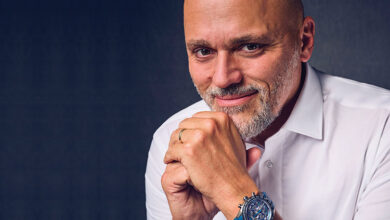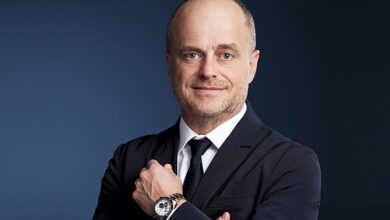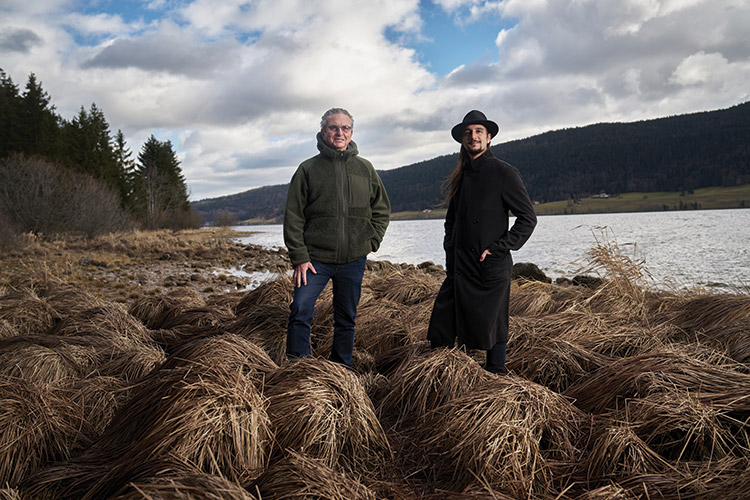
In this series that is featured every month, “Day & Night” focuses on individuals or brands that have impacted the world of haute horlogerie positively… Today, we focus on a newcomer to the world of watchmaking – Renaud Tixier, a brand that has been creating waves even before it was formally announced. That is because it is the creative alliance of two generations of exceptional watchmakers: Dominique Renaud, the pioneering figurehead of contemporary horology and Julien Tixier, a prodigious young talent
DOMINIQUE RENAUD – THE OLDER MASTER WATCHMAKER
Born in a family of watchmakers with prestigious antecedents, Dominique Renaud always knew that his life would be dedicated to horology. After his primary education, he enrolled in the National Watchmaking School of Besançon in France, from where he obtained his watchmaker’s license in 1976. He worked with various small watchmakers until in 1979, when “I moved to Switzerland and applied to work at Audemars Piguet. During my time at Audemars Piguet, I met Giulio Papi. We were both working on complicated watches and developed an excellent rapport. Shortly after, we both decided to quit and form our own company, Renaud & Papi; that was in 1986.”
Renaud & Papi
When they started their eponymous brand, the two young watchmakers dreamed of one day owning a big company. In reality they started out as a small company, but their growth was phenomenal, and they grew rapidly. “Brands came to us because we were unique at that time as we created complications. The brands, at that time, did not create any complications so we were very successful. Our success was not immediate, but we grew very fast because we were unique – the first company to do complications for other brands. That is how we started.”
Renaud & Papi was at the forefront of high watchmaking and was involved in inventing, developing, and creating some of the most complicated timepieces in the watchmaking industry. The company’s portfolio of clients read like a Who’s who of the high watchmaking brands, but Renaud was feeling constricted. In 1992, Audemars Piguet acquired a substantial stake in Renaud & Papi; soon after, Renaud left the company. Explaining his disenchantment, Renaud says, “I decided to quit for private reasons, but also because all the brands were asking Renaud & Papi to create complications, but only traditional complications and nothing that pushed the envelope. I decided to leave Renaud & Papi and take a break from watchmaking.”
Renaud spent a few years in the South of France, technically on a break, but still continuing to imagine watchmaking novelties – “Something very different from what the brands were asking for. I then came to the realise that I wanted to create something really special for myself.” This prompted him to come back to the watch industry because he was now ready to break all the rules and to create something totally new.
DR01 Twelve First
The DR01 Twelve First was Renaud’s comeback statement – one that made a big splash in the world of high horology. “The main goal was to break the rules, to change the way of looking at the movement and to express my abilities through a masterpiece.” The DR01 Twelve First was a phenomenal product with a new oscillating regulating organ inside. Everything was totally new and disruptive – even the case. It was Renaud’s attempt “To open a window to thinking differently.”
JULIEN TIXIER – THE YOUNG SAVANT
In contrast to Renaud, Julien Tixier has no genealogical antecedents in the world of horology. His fascination, on the other hand, began as a small boy growing up in Bordeaux, in the southwest France. A little boy, peering over the dining table at the wrist of one of the guests, was mesmerised by the beating heart of a mechanical watch glimpsed through the open caseback. Young Tixier had “Just discovered the beauty of a mechanical watch, its watch movement and I felt that it was a little piece of life, and it was in that moment that I decided that I want to create these kind of things. After many years, I started at the watchmaking school in Bordeaux, where I was for the first four years. After that, I moved to Morteau where I studied for another two years so I learned watchmaking for a total of six years and in those six years discovered two distinct approaches to watchmaking – from industrial to high-end and bespoke watchmaking, which completely blew my mind.”
Sébastien Rousseau
On completion of his education, Tixier credits his workplaces for the enormous amount of watchmaking skills he acquired. One of his first teachers was Sébastien Rousseau, with whom he worked on a special automaton project for a client. Tixier describes this period as “second part of my internship, because working on automatons is a dying art and not many people even know how to do this.”
Laurent Ferrier
Tixier’s first official job was with Laurent Ferrier and “I learned many, many things in in this workshop and the essentials of watchmaking – what it really is, how you need to be passionate about it, the way to be a real watchmaker. I also learnt all aspects of watchmaking – decoration, assembly, setting, casing, and so on. I worked on pretty much everything and learned ever aspect. It was a kind of revelation; this the way I want to manage a team or to create something. I think it was a very good experience for me.”
Luca Soprana
“After that I moved to a little workshop and worked with crazy guys and crazier prototypes,” is how Tixier describes his stint with Master Watchmaker Luca Soprana, with whom he worked “to help create a very special piece, a highly complicated piece.” For Tixier, who thought he had learned all about watchmaking at Laurent Ferrier, Soprana’s workshop was “like slap in my face and I again learned many new things. We were making components and creating everything in a little workshop in the corner without modern tools. But with techniques that were just impressive and new to me. In six months, I learnt more there than in all my watchmaking years, because here we were doing everything by hand, with old-school machinery.”
It was then that Tixier realised “I absolutely did not have the skill sets and levels to create a watch from A to Z, so I kicked myself to learn more. I then established my workshop in the Vallée de Joux, where I continued to learn and create watches.”
MEETING OF MINDS
Long before Tixier met Renaud, he had heard of him from one of his teachers. “Everybody knows of Dominique; one of my teachers, when I started my watchmaking courses said that one day you must try to work at Renaud & Papi. A few weeks ago, I sent him a message saying, ‘I don’t work at Renaud & Papi, but I work with Dominique now.’ When I first met Dominique, the connection was immediate and we kept in contact like friends, exchanging news, sometimes calling each other, or visiting the other’s workshop.”
Tempus Fugit
Sometime after Tixier had set up his workshop, Renaud got in touch with him about a special project – a secular calendar with a life power reserve, the Tempus Fugit. “When Dr Benoît Dubuis and Dominique explained to me about this project and told me ‘We just want to create a special piece with a special approach. It is like an empty canvas, and you can do whatever you want to express yourself. We have only one condition – we need a counter that keeps a countdown of the wearer’s life expectancy.’ That is the speciality of the Tempus Fugit: it features a countdown to the life expectancy of the owner.
“That was the aim of the watch, and it is really special. It sounds awful when we first try to explain it, but it is not. In reality, the aim is not to tell you when you will die but tell you to fully live your life. It is a very complicated mechanism and is the subject of a patent and is based on DNA sequences and markers.” Explaining the Tempus Fugit’s life power reserve counter, Tixier likens it to a gauge; “In the watch, it’s just a kind of gauge and this gauge moves one unit at a time for each year and it is programmed to complete in 100 years. It will be reprogrammed for the next owner when they acquire it.”
Furlan Marri Secular Perpetual Calendar
The next joint project for the duo was the Furlan Marri Secular Perpetual Calendar, which they created in collaboration with Andrea Furlan of Furlan Marri for Only Watch. Tixier stresses that it is actually a story of a friendship rather than a business collaboration. “It is a real story of friendship because Dominique introduced Andrea to me, and we become really good friends very quickly. Then, Andrea suggested that it might be a good idea to do a timepiece together for Only Watch and we said, ‘OK, let’s do it’.”
The trio decided “To create the most optimised secular calendar and put it on a timepiece for the Only Watch project. We had to do it in a very short time of work because the whole project was realised in nine months – i.e., the conception, design realisation of each component, construction, case, dial, hands, and assembling the watch.”
GENESIS OF BRAND RENAUD TIXIER
It was the experience of working with Renaud on such special projects that made the duo realise how well they mesh together. Tixier explains, “The experiences of working on such special projects, a unique piece each time, made us realise that we can work together naturally, without too many questions or discussions. After these kind of experiences, it was natural for us to decide to work together. We clicked and everything has worked out very smoothly.”
Renaud Tixier has been set up with the support of friends and well-wishers who believe in the synergetic magic that the duo creates. The company has five shareholders in total – in addition to Renaud and Tixier, it includes three friends who have invested. The investors are not looking for financial profits, rather they are happy to support Renaud and Tixier work together to realise their horological dreams. Hiring skilled watchmakers, which can be a difficult task, is a no-brainer as far as Tixier is concerned. “I find my watchmakers through my students. For instance, there is currently in my workshop, a young student completing his training period. Soon, he will be our second employee. This works out well because we know and they know how we work, what kind of people we are, and what kind of motivation there is on both sides.”
Monday timepiece
The marque’s first offering is the Monday timepiece, which features a calibre centred around a micro-rotor, re-envisioned to maximise winding efficiency. Renaud explains how he had for a few years been thinking about improving the micro-rotor. His search led him to a space ripe for innovation: the rotor’s centre. While the rotor’s periphery is active, its centre remains largely untapped. Here, Renaud decided to install an auxiliary mechanism, designed with a straightforward mission: to optimise the use of energy generated by the rotor, capturing even the slightest joule to power the watch. True to his methodical approach, Renaud visualised the problem and its solution clearly in his mind, leading him to conceive a central propeller for the micro-rotor. He fittingly named this dynamic component the ‘dancer’ – a spring-powered mechanism that literally ‘dances’ at the heart of the watch’s movement.
The ‘Monday’ project transcends mere invention. A completely new calibre has been crafted around the ‘dancer’ micro-rotor, not only to feature but also to elucidate the significance of this innovative mechanism.
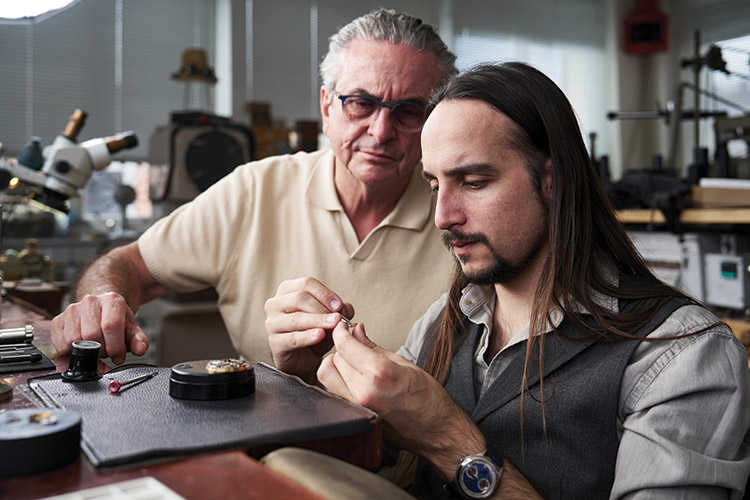
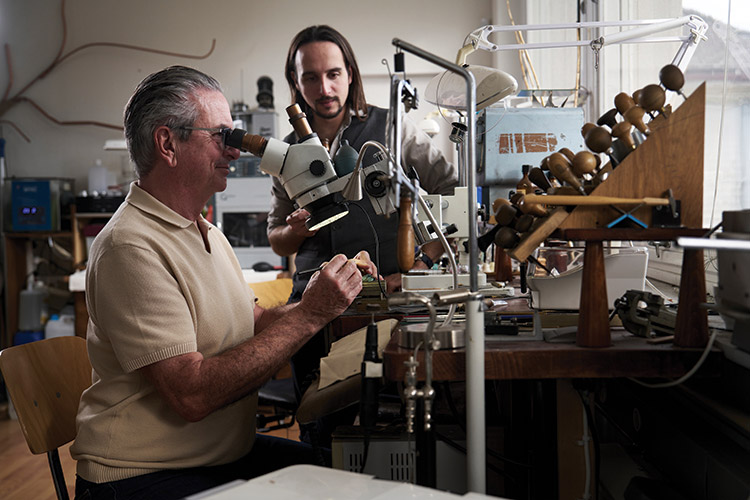
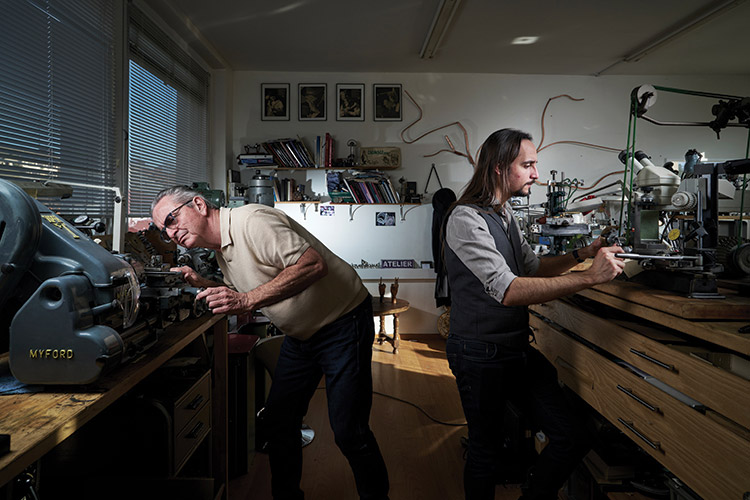
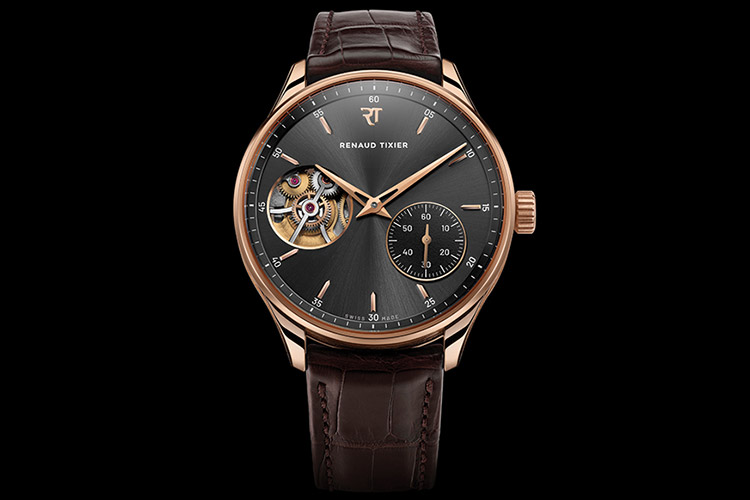
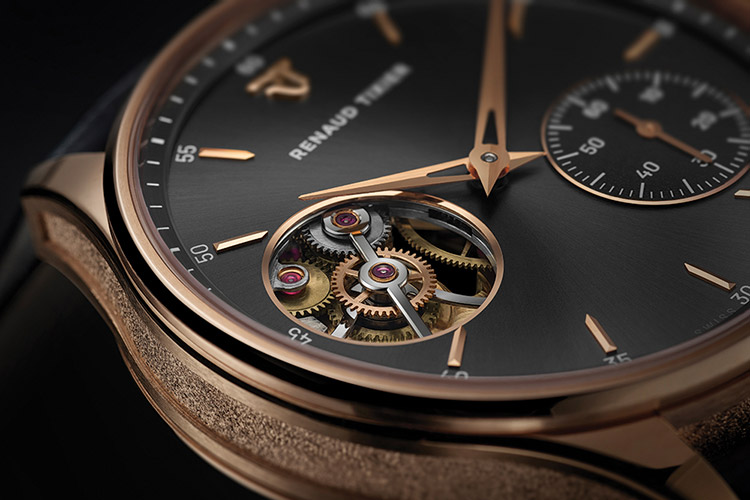

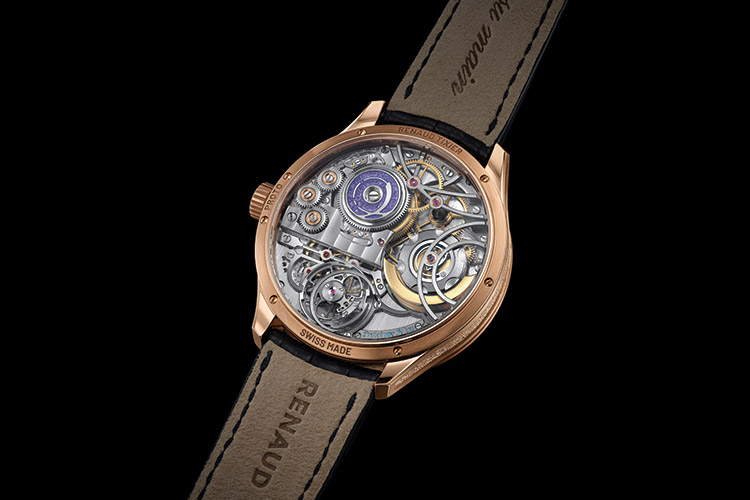
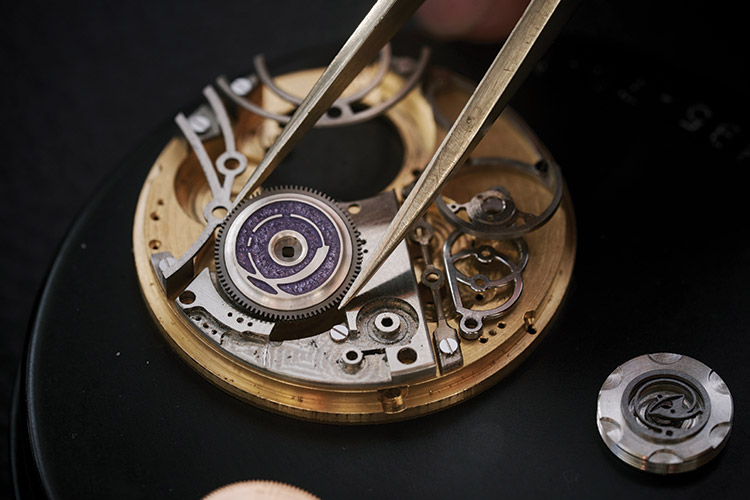
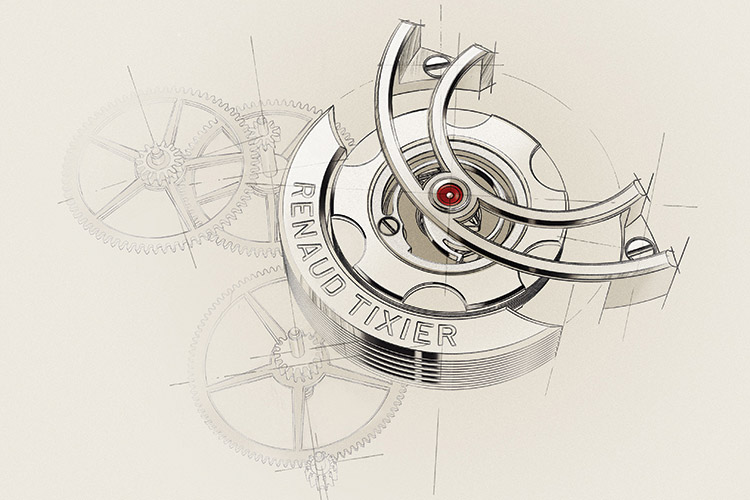
Renaud Tixier creations are available in the region at Perpétuel on https://perpetuel.com/



